Introduction: In this article, Gena Philibert-Ortega found a wallet-sized WWII discharge certificate in an antique shop, and did some research to learn more. Gena is a genealogist and author of the book “From the Family Kitchen.”
Do you have a World War II veteran in your family tree? Did you inherit or order any military documents? One document you may find with a veteran’s belongings is an honorable discharge certificate.
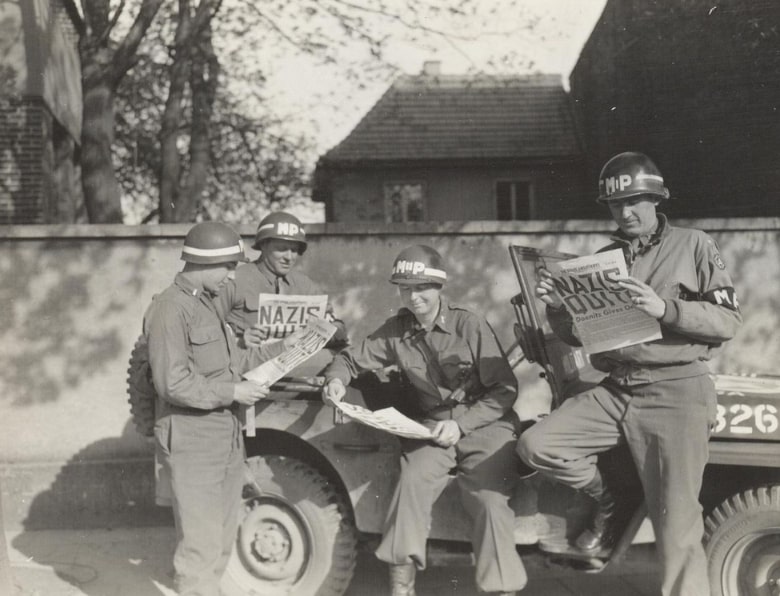
What does having an honorable discharge mean? Leaving the military with an honorable discharge means that the veteran served his or her country, “followed the rules and obeyed the law.” With an honorable discharge a veteran could apply for benefits and even re-enter the military if they wanted to. (1) These veterans received a certificate that declared they were honorably discharged and included information about their service on the back side of the document.
Recently I purchased a laminated wallet-sized honorable discharge from an antique dealer. The discharge was for a World War II veteran, Charles Oliver Wetzel Jr., who was a staff sergeant in the U.S. Marines. (2) The miniature document made me wonder why a veteran would have a copy like this of their discharge and where they may have obtained it.
Wallet-Sized Honorable Discharges
Why a wallet-sized honorable discharge? Military researcher K.B. Barcomb states that:
“One’s discharge was the single most important military document for World War II veterans. Showing it was required for access to a multitude of benefits, along with admission into veterans’ organizations and even some community support events. While the original was required to apply for benefits, having a wallet-sized version was convenient, readily accessible, and reduced the wear and tear of folding and unfolding a full-size copy.” (3)
Even though the miniature version wasn’t “official” it could have been useful in some situations. After researching World War II-era veteran guides, it appears that veterans were encouraged to do several things upon release from the military, including making copies of their discharge paper. In Connecticut, the Veterans Service Center Manual explained that several places provided a photostatic service and could provide a wallet-sized copy of an honorable discharge certificate in two hours or less. (4)
Surprisingly, some of the places that offered this service were department stores. Around 1945-1946, men’s departments in stores advertised that if a veteran brought in their discharge certificate, they would make a small copy and laminate it so it could be carried in a wallet.
This 1945 announcement states:
Raleigh [Haberdasher] offers this free service to all veterans… this wallet-size photostat of your discharge certificate sealed in transparent plastic.
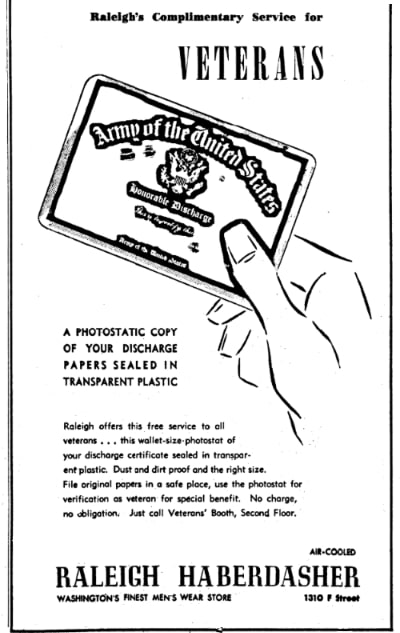
The store Comays not only offered (for sale) honorably discharged emblem pins but also an “auto-tag” to attach to a car’s license plate. These two items were for sale, but the veteran could bring their discharge certificate in to receive a free miniature discharge certificate covered in plastic for their wallet.
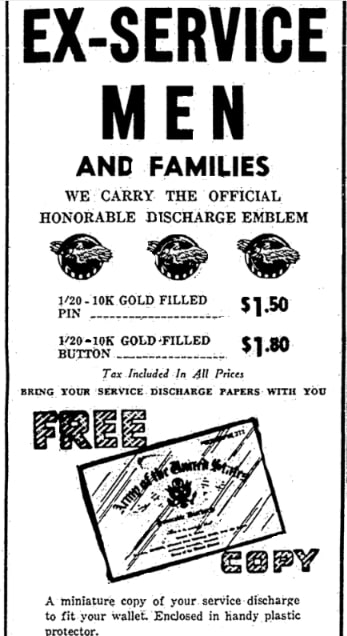

This newspaper advertisement not only offers to make a wallet-sized copy of a discharge certificate, it reminds the veteran to have the paper recorded by the register of deeds first.
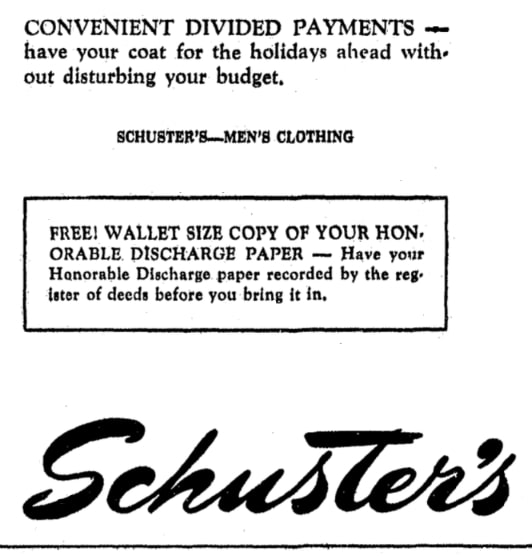
Grossman’s in Michigan offered a “plasticized, reduced print of your discharge papers” that was photographed while you waited and then picked up a few days later.
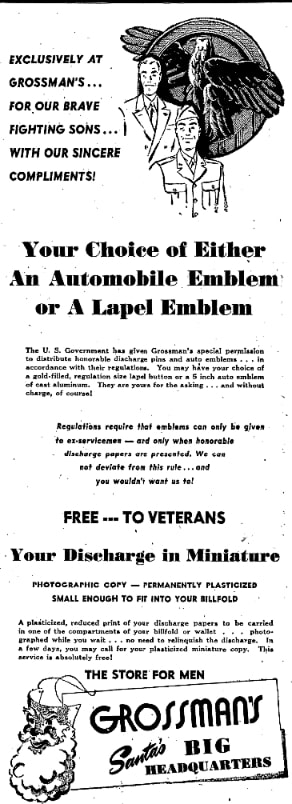
This free service wasn’t the only one offered to veterans. Retailers focused on marketing to honorably discharged veterans by offering them special cases or wallets to place military papers and dog tags in. This advertisement for Shaw’s Jewelers offers this case to all veterans, including women, listing WAVES, WACS, Soldiers, Sailors and Marines. This is one of the few advertisements I found that acknowledged that women were also veterans.
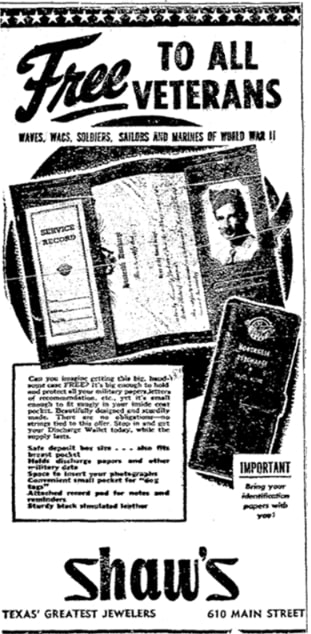
It appears that by mid-1946 the offers of free wallet-sized reproductions of discharge certificates were mostly gone. Those who still wanted to have one could purchase them at a place that laminated important items like Social Security cards.
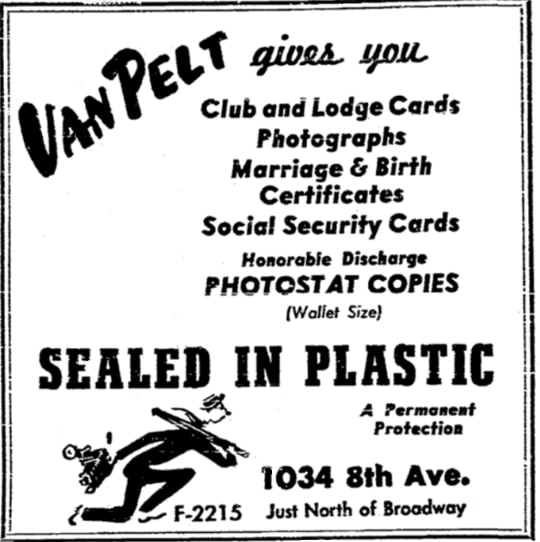
What Was in the Veteran’s Wallet?
The ability to get a wallet-sized laminated copy of your discharge certificate is one that World War II veterans could acquire from some department stores or printing shops. It appears that this was a marketing tactic that not only thanked veterans for their service but also brought customers into the store’s doors. However, it’s not something all veterans took advantage of or even knew about.
In interviewing one World War II veteran, he remarked that he never had a need for showing his honorable discharge certificate and he didn’t have a wallet-sized version. Because he lived in a rural area, it may not have been something available from local retailers. It’s possible that veterans in larger cities were more likely to take advantage of this free service. (5) So while some may find this type of honorable discharge in a veteran’s belongings, it wouldn’t be something everyone had. Did your ancestor have one?
Explore over 330 years of newspapers and historical records in GenealogyBank. Discover your family story! Start a 7-Day Free Trial
___________________
(1) “Types of Military Discharge and What They Mean for Veterans,” Law for Veterans (https://lawforveterans.org/work/84-discharge-and-retirement/497-military-discharge :accessed 18 August 2023).
(2) Family heirlooms end up in antique sales for all kinds of reasons. If you are a relative of Mr. Wetzels, let me know and I’d be happy to give you this heirloom.
(3) Email to Gena Philibert-Ortega.
(4) Connecticut Veterans’ Reemployment and Advisory Commission, Veterans Service Center Manual. Hartford, Connecticut: State Department of Education, October 1945, pg. 8. Available from Hathi Trust, https://hdl.handle.net/2027/coo.31924002250268?urlappend=%3Bseq=29%3Bownerid=27021597770109864-33
(5) Special thanks to Tami Mize for interviewing her dad, Malcome Osmer, who was a tail gunner in the U.S. Navy (1943-1945). A big thank you for his service during World War II and his willingness to be interviewed.
